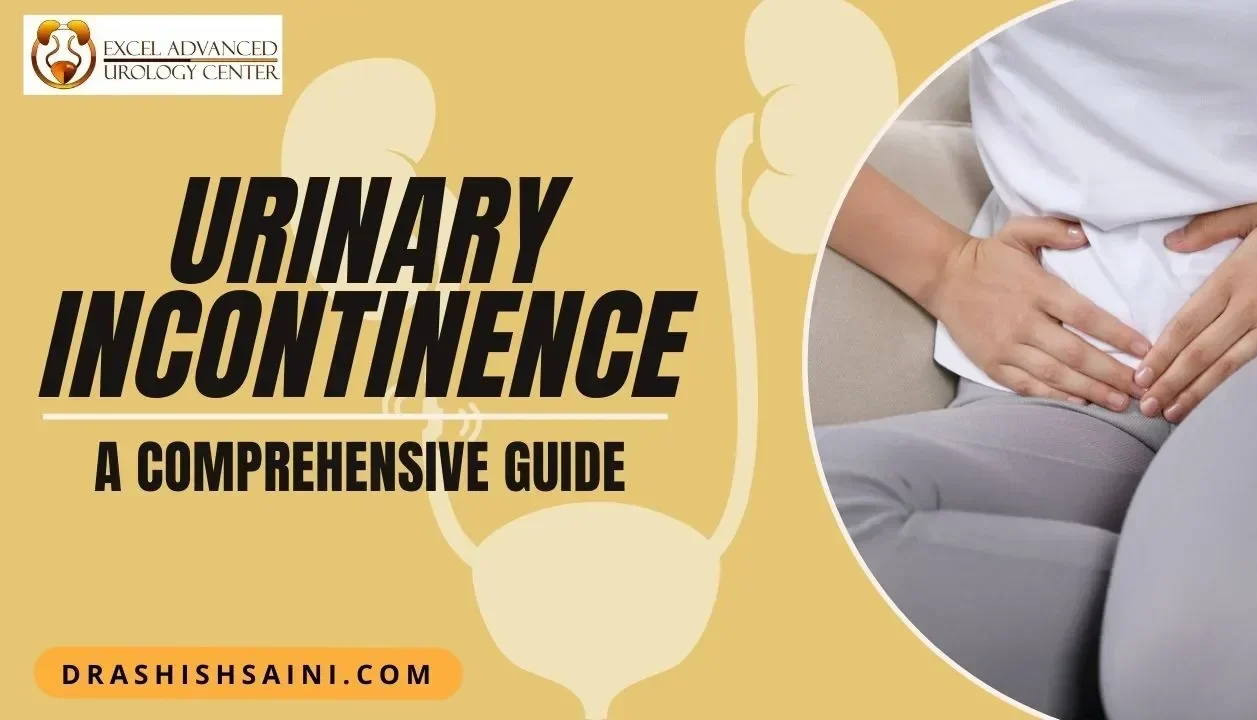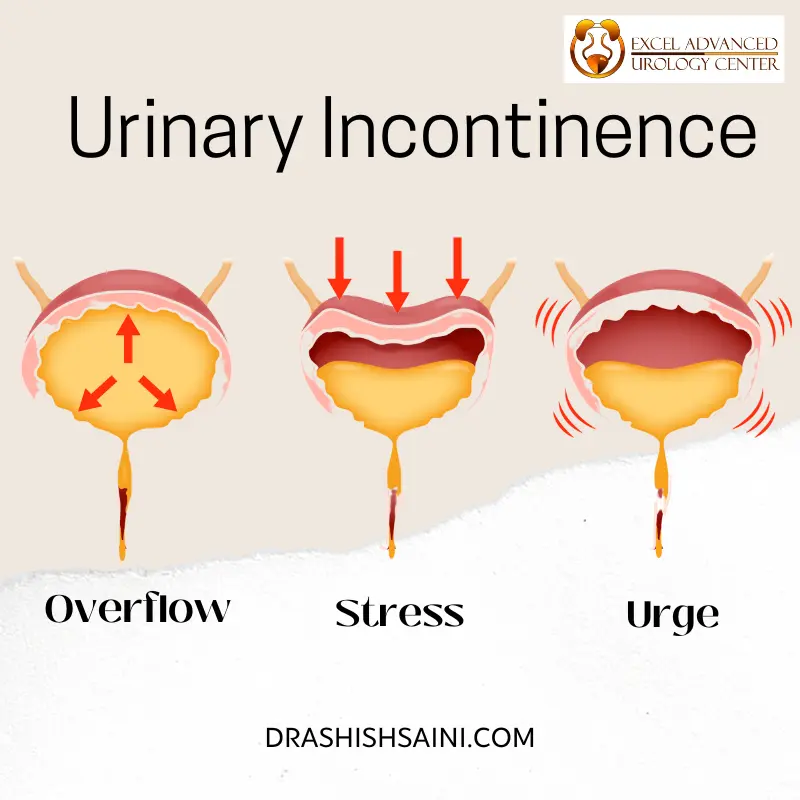



The unintentional spilling of urine is known as urinary incontinence. It denotes the act of urinating against one's will. The ability to control the urinary sphincter is either lost or diminished. It can occur before and after pregnancy, be brought on by stress-related events like coughing, and is more prevalent in circumstances like obesity. As you become older, the likelihood of it happening rises.
Dr Ashish Saini presents this blog to raise awareness of urinary incontinence among those who might need it the most by highlighting the causes and treatment options for it.
The issue of urinary incontinence is widespread and affects many people. The American Urological Association estimates that between 25% and 30% of men and women in the country have urinary incontinence.
Urinary incontinence in females is more frequent than Urinary incontinence in males. In comparison to 1.5-5% of men, it is expected to affect 30% of women between the ages of 30 and 60.
Not only is urinary incontinence a medical issue. It may impact social, psychological, and emotional health. Urinary incontinence sufferers frequently experience anxiety when performing routine daily tasks. They prefer to be close to a bathroom. People with urinary incontinence may find it difficult to enjoy life.
The urinary function is managed by the bladder and the brain. Urine is held in the bladder until you're ready to expel it. The bladder is held in place by the muscles in the bottom portion of the pelvis. The bladder's smooth muscle is normally at rest. As a result, the bladder can store urine. The bladder's neck (end) is sealed up. The urethra is enclosed by the sphincter muscles. The tube that conveys urine from the body is called the urethra. Urine doesn't leak when the urethra is kept closed by the sphincter muscles.
The brain signals the bladder when you are prepared to urinate. The bladder's muscles then tighten. The urethra, the tube that transports pee from the body, is forced to empty as a result. Sphincter muscles open up when the bladder contracts.
Drinks, meals, and drugs that stimulate the bladder and aid in urinary incontinence causes are known as diuretics. They consist of:
Additionally, numerous conditions, such as urinary tract infections, vaginal infections or irritations, or constipation, can lead to urinary incontinence causes. Some drugs have the potential to induce momentary bladder control issues. Weak pelvic floor muscles or a weak bladder may be to blame for incontinence that lasts longer.
You can identify the type of urine incontinence you have based on the symptoms.
Incontinence is not always chronic. Because certain reasons are transient, incontinence will stop when they do. Temporary incontinence may result from vaginal infections. It can be brought on by irritability, medications, constipation, and limited mobility. Temporary incontinence is frequently brought on by urinary tract infections (UTIs), which need to be treated.

Bladder Incontinence is not a disease. It is a sign of numerous illnesses. Urinary Incontinence in males and urinary incontinence in females causes could be different. However, it is not inherited. It is also not merely a natural component of becoming older. The four forms of urinary incontinence are as follows:
Weak pelvic muscles in SUI allow urine to escape. One of the most prevalent types of urinary incontinence is this one. It frequently affects older women. In men, it is less typical.
When the muscles in the pelvic floor have been strained, SUI occurs. The bladder experiences pressure from physical exercise. A bladder leak then occurs. Exercise, walking, bending, lifting, and even sneezing and coughing might cause leaking. A few drops to a tablespoon or more of urine may be used. SUI can range from minor to severe.
Although there are things you can do, there are currently no FDA-approved medications to treat SUI. Kegel exercises to strengthen the pelvic floor are one way to control SUI. Other methods of managing SUI include lifestyle modifications, vaginal and urethral devices, pads, and even surgery.
Another typical form of urine incontinence is OAB. Additionally known as "urgency" incontinence. In the United States, OAB affects more than 30% of males and 40% of women. It influences how individuals live. They might limit what you can do. They might worry that even though a bathroom is not nearby, they would suddenly need to urinate. They might not even be able to sleep soundly at all. Mixed incontinence refers to the condition in which a person has both OAB and SUI.
When you have OAB, even when your bladder isn't full, your brain signals it to empty. Or the muscles in the bladder are overly active. To pass urine before your bladder is full, they contract (squeeze). This triggers the need or urge to urinate.
The urgent urge to urinate is the primary symptom of OAB. You can't ignore or suppress the want to leave. The need to urinate frequently during the day and night is another symptom. Men with prostate issues and women after menopause are more likely to develop OAB. It has a variety of causes.
Some people experience sudden urine leakage (SUI) (where urine leakage in women is more) and frequent urges to urinate. Mixed incontinence is this. The individual has both OAB and SUI.
Overflow incontinence occurs when the body produces more urine than the bladder can contain or when the bladder is full and unable to empty itself, both of which lead to urine leakage. Additionally, there can be something obstructing the urine's flow or the bladder muscle might not be contracting (squeezing) correctly. Frequent, small-volume urination is one symptom. Another sign is "dribbling," which is a continuous leak. Women rarely have this kind of urine incontinence. Men with prostate issues or those who have had prostate surgery are more likely to experience it.
The signs for each are as follows:
SUI's primary symptom is leakage while you are moving. Depending on how bad the SUI is, there will be activity and leaking.
An uncontrollable, sudden urge to urinate is the primary symptom of OAB. Your bladder may or may not leak urine as a result of the urge.
A sudden, intense urge to urinate as well as leaking are signs of mixed incontinence. When you experience multiple incontinence types, you have mixed incontinence. People with mixed incontinence typically have both SUI and OAB.
The main signs of overflow incontinence are continuous dribbling and frequent, tiny urinations. The bladder can't empty itself. Whenever the bladder is full, symptoms appear. Although this variety is less common in women, diabetes, lowered bladders, and previous bladder procedures may have an impact. Men having a history of prostate issues or surgery are more likely to experience it.
Numerous drugs can lessen urine leakage in women. Some of these medications reduce the issues associated with an overactive bladder by stabilising muscle spasms. Other drugs have the opposite effect, relaxing your muscles so that your bladder can empty. Normal bladder function may also be helped by hormone replacement therapies, which frequently involve replacing the oestrogen that is lost during menopause.
Urine collection and storage tools and supplies are widely available for Urinary Incontinence Treatment. They support the management of urine incontinence and retention. Urinary retention prevents your bladder from entirely emptying. You cannot control urine leaking when you have urinary incontinence (UI).
Men and women of all ages can benefit from products and gadgets considered for urinary incontinence treatment. They are the only option for some people to treat bladder issues. Additionally, these gadgets can increase the freedom of elderly and disabled people.
Your bladder harbours an "indwelling" catheter that is there 24 hours a day. Indwelling catheters come in two different varieties. In your urethra, indwelling "Foley" catheters are inserted. Through a tiny surgical incision in the abdomen, "suprapubic" catheters that are ingested pass above your pubic bone. A balloon keeps the tube in your bladder in both forms. Additionally, they both discharge urine into a bag outside the body. It is considered a very effective urinary incontinence treatment.
There are external collection devices for men called Texas catheters or condoms. The penis is covered by these unique condoms. They are held in place by straps or glue. The tips of the condoms are holed. From the hole, a tube leads to a drainage bag. Incontinence urine gathers in the drainage bag.
Drainage bags are attached to both internal and external collection devices. They catch the bladder's leaking urine. There are various sizes for drainage bags. 1500 to 2000 millilitres (1.5 to 2.0 litres) of pee can fit in an overnight bag. These are big and impossible to conceal.
"In and out" catheterization is another name for intermittent catheterization. "Clean intermittent catheterization" is another name for it. You don't need gloves or sterile preparation because it is clean.
Three to five times each day, a catheter is placed into the urethra. Once your bladder is empty, you take out the catheter and discard it. The catheter can be inserted by you or a caregiver. You do not need to wear it constantly. This reduces the likelihood of infection. The indwelling catheter has a balloon, whereas these devices don't.
For urinary incontinence treatment, absorbent goods like pads and adult diapers are available. There are numerous styles. The adhesive strips on some pads and pantyliners are designed to stick to underwear. Additionally, there are protective underwear, adult briefs, and undergarments. Men's guards and drip collection pouches are available.
If you are unable to access a regular restroom, portable gadgets might be quite useful. Commode seats and bedside toilets are examples of these appliances. Bedpans and urinals are also available.
Close to the bed is a commode by the bed. Using it at night or on the floor of the house without a bathroom is simple. You should think about a commode's height, weight, ease of emptying, seat type, and price when selecting one. It might be more comfortable on a soft surface.
[elementor-template id="1491"]
Dr Ashish Saini is the best urologist in Delhi who can pinpoint the cause of your sexual health issue and suggest the best course of treatment. For women facing issues with their sexual, mental, reproductive, hormonal, and lifestyle behaviours, Dr Ashish Saini's excel advanced urology center established a platform. Spend less time stressed out by taking a health analysis check.